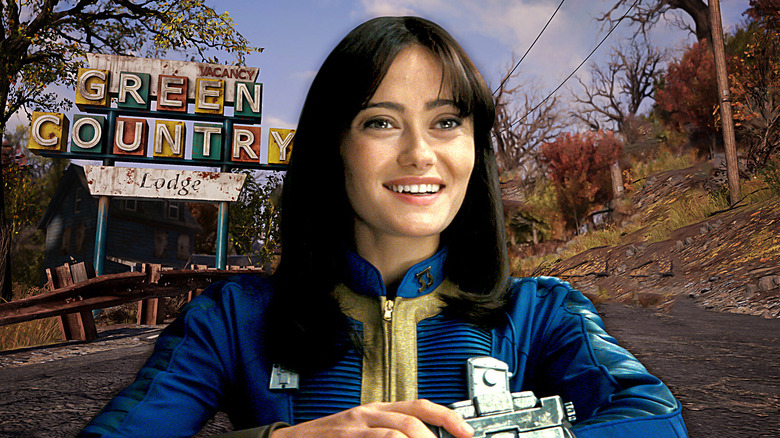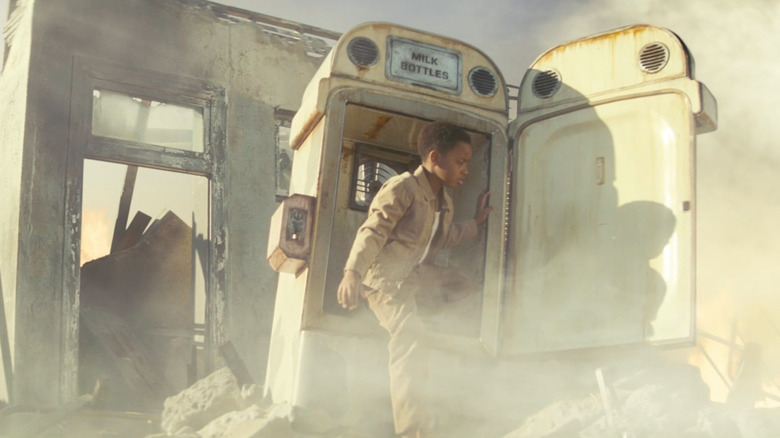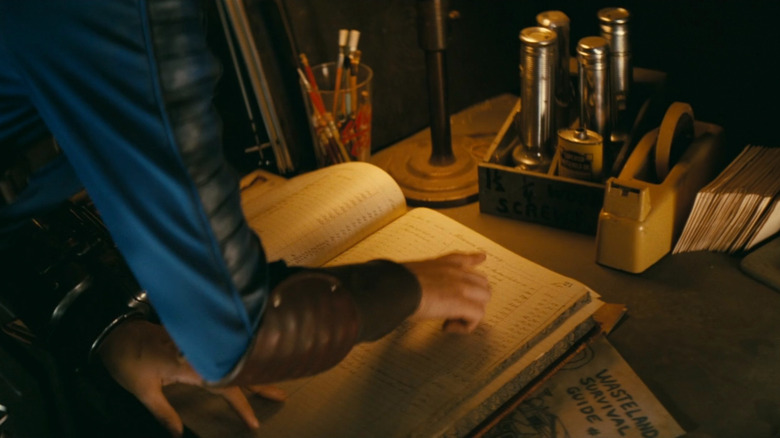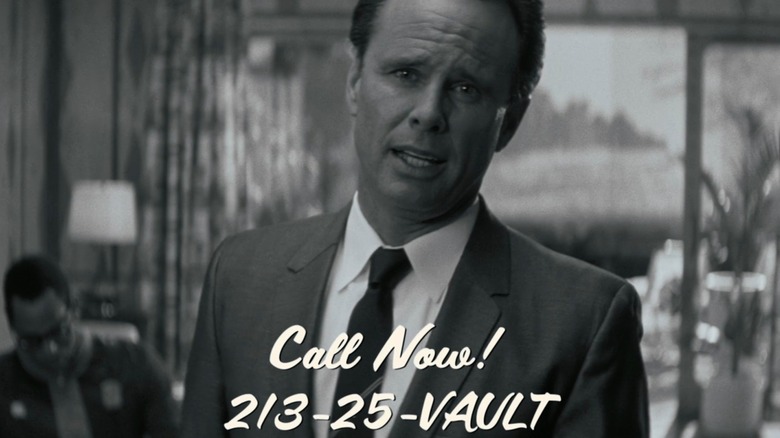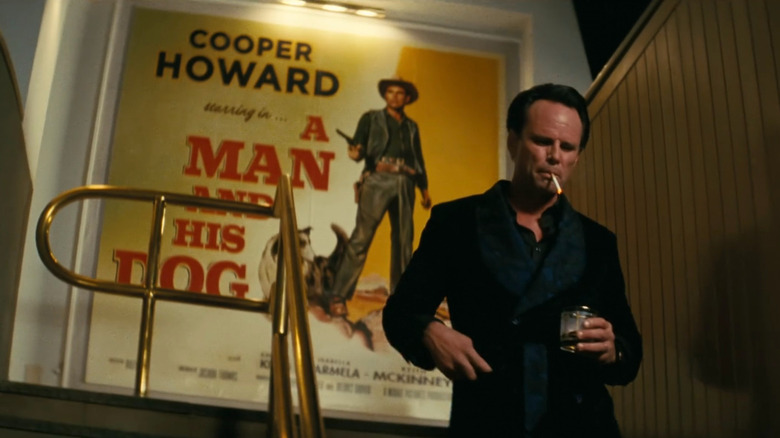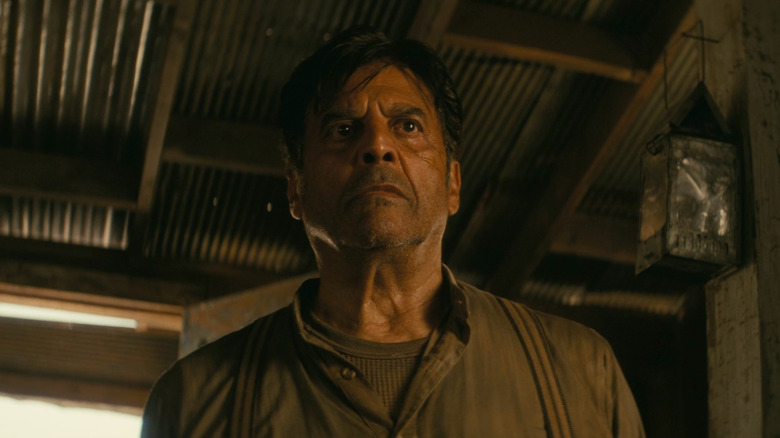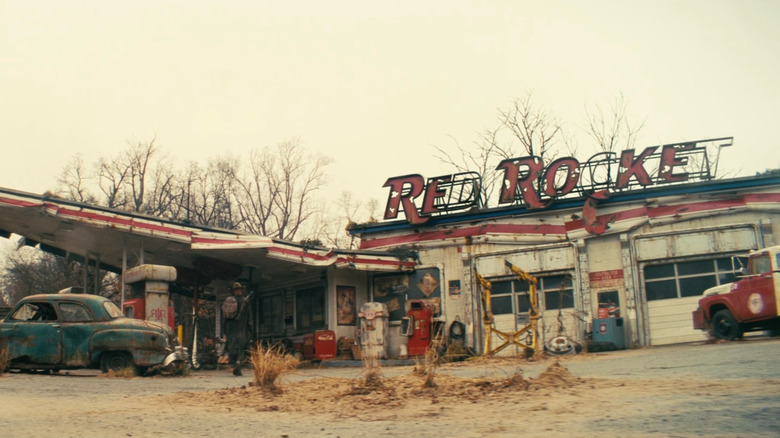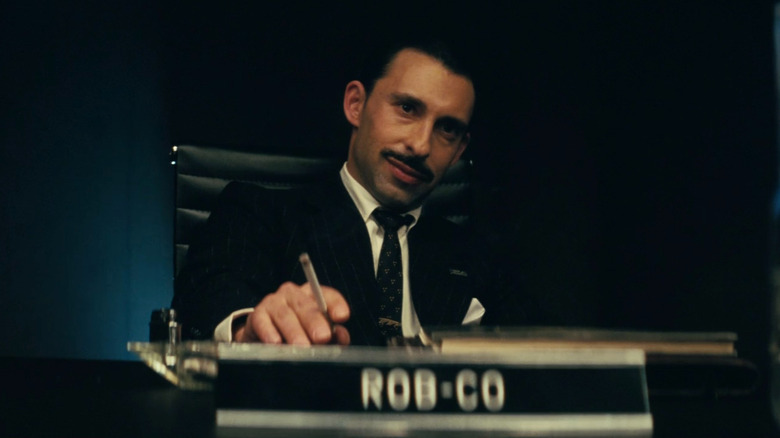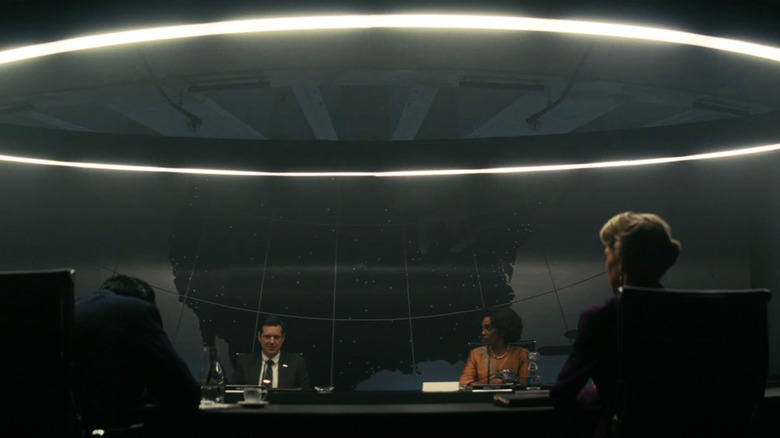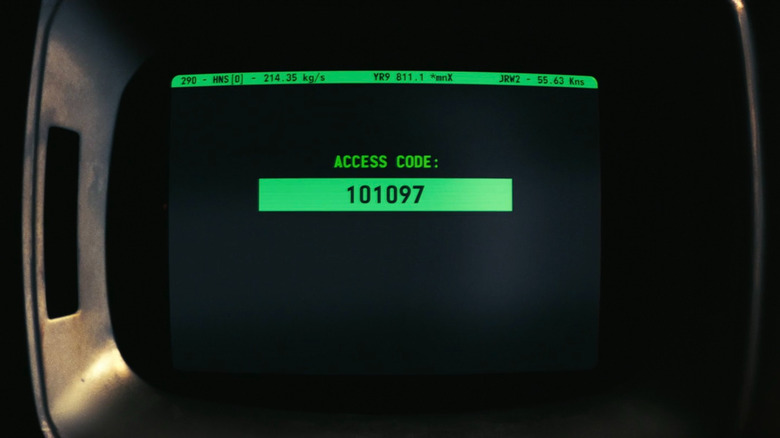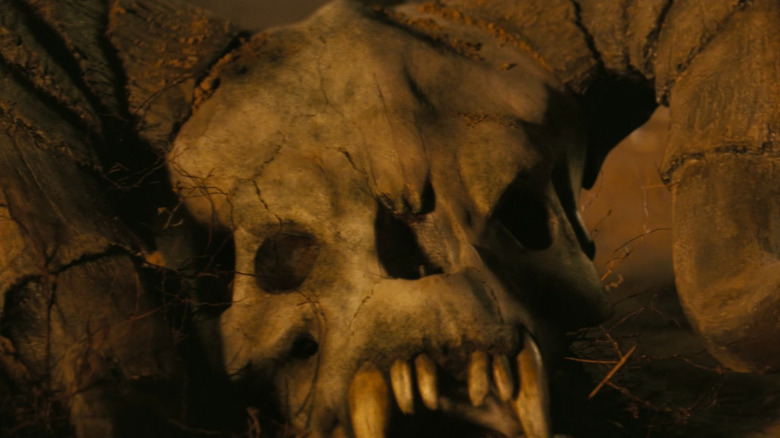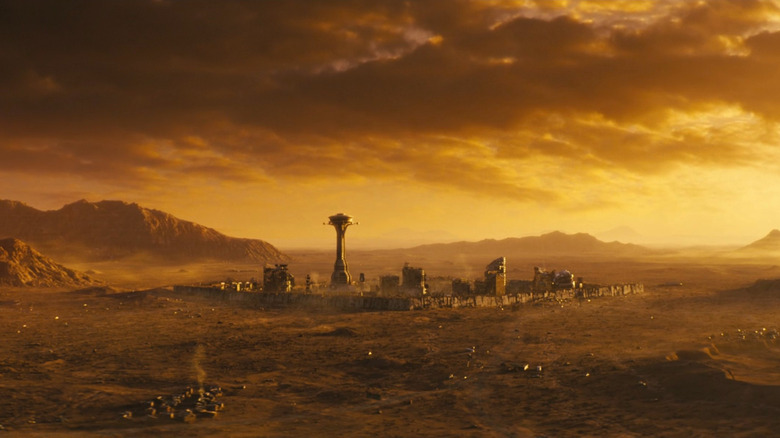Easter Eggs You Missed In Fallout Season 1
Contains spoilers for "Fallout" Season 1
If there's one thing we didn't expect to see before the apocalypse, it was the resurgence of video game adaptations. There have been some real stinkers over the years, and at one point it seemed as though successfully adapting a video game for the screen was simply an impossible task. And yet, here we are in the 2020s, having witnessed firsthand how well streaming services can handle video games like "Twisted Metal," "Halo," and "The Last of Us" — HBO's adaptation of the latter earned critical acclaim and Emmy awards as it set a new gold standard.
Now, Amazon Prime Video's "Fallout" has risen to meet this standard (at least, according to Rotten Tomatoes), providing viewers with a riveting adventure that's every bit as inventive as it is faithful to the source material. It certainly doesn't hurt that the "Fallout" franchise enjoys a deep well of lore to draw from. Eagle-eyed fans of the games will no doubt have enjoyed the many references to the wider world of the Wasteland, and film buffs likely loved the subtle nods to a cult classic that inspired "Fallout." If you're wondering what you may have missed, fear not: We've compiled a list of our favorite Easter eggs from the first season of "Fallout" just for you.
Nuclear fridges are back
If we had a bottle cap for every time the "Fallout" franchise referenced an infamous "Indiana Jones" scene... Well, we'd have three bottle caps. It may not seem like a lot, but it's weird that it's happened thrice! Yes, we're talking about that often derided moment from "Indiana Jones and the Kingdom of the Crystal Skull" in which Harrison Ford's iconic swashbuckler survives a nuclear test at the Nevada "Doom Town" site by hiding in a fridge. The interior logic of the film holds that the fridge — being lead-lined — would protect Indy from radiation. The exterior logic of reality holds that a nuclear explosion — being a nuclear explosion — would have given Dr. Jones an immediate "Game Over," fridge or no fridge.
In Prime Video's "Fallout," Maximus (Amir Carr, playing a younger version of Aaron Moten's character) is shown surviving the nuclear destruction of Shady Sands by hiding in a fridge. While it's a clear reference to the aforementioned "Indiana Jones" scene, it also harkens back to a similar sight-gag in "Fallout: New Vegas" (where the player can discover a fridge filled with bones and Jones' signature hate) and the "Kid in a Fridge" side-quest from "Fallout 4." It's clear the "Fallout" team have always held "Indiana Jones" in high regard, which should give those waiting for Bethesda's "Indiana Jones" video game some hope.
The Wasteland Survival Guide makes an appearance
One of the most memorable locations from "Fallout" Season 1 is Filly, a seedy town that perfectly encapsulates just about every horrible aspect of the Wasteland in a few square miles. (Incidentally, Filly is not located anywhere near Philadelphia, but rather somewhere near Santa Monica.) At the center of the town is a landfill that residents mine for pieces of discarded technology that they may be able to use or sell. This early locale provides Lucy (Ella Purnell) with the perfect place to organically learn what she needs to know about this new world she's entered.
Of course, she might learn a lot more if she spent a little more time investigating Ma June's (Dale Dickey) storefront, which just so happens to sell a copy of the "Wasteland Survival Guide." Conspicuously placed in the background of some shots, the "Wasteland Survival Guide" is well known to players of the "Fallout" games. Its author, Moira Brown, is an NPC inventor and shop-owner who the player interacts with frequently during a multi-part side quest in "Fallout 3." While it's unlikely that viewers will ever see Moira in the Prime Video series (outside of a flashback, at least), it's strangely heartwarming to be reminded of her here.
You can actually call that Vault-Tec number
In "Fallout" Season 1, Episode 6, entitled "The Trap," viewers learn more about the pre-War life of Cooper Howard, the actor-turned-ghoul played by Walton Goggins. Apparently, when he wasn't starring in Western flicks, Cooper was the commercial spokesman for Vault-Tec, the nefarious mega-corporation responsible for building the dystopian vaults in which America's richest citizens survived the nuclear apocalypse. Of the four "Fallout" factions, Vault-Tec's power is the most absolute — and perhaps the most deadly, too.
As Cooper takes us on an appropriately sterile tour of Vault 4 (where we later see Maximus and Lucy's relationship take an equally sterile turn after some decidedly unsexy sexy talk), a phone number flashes up on screen: 213-25-VAULT — or (213) 258-2858. As some fans have already discovered, this phone number is actually active and tied to the "Fallout" series. If you're in the United States, you can call the number. When you do, you'll hear a voice (presumably that of Goggins' character) screaming in a manner that's totally jarring when compared to the commercial. It's one of the best real-fake-phone numbers we've seen in a while.
A Man and His Dog is a nod to a cult classic movie that inspired the Fallout games
"The Trap" also gives viewers a window into what Cooper Howard's home was like (y'know, back when he had a nose and wasn't a murderer). On one of his walls, fans can spot a poster for one of his films — a Western titled "A Man and His Dog." If that name sounds somewhat familiar, it might be because you've come across the real 1975 science fiction comedy film "A Boy and His Dog."
This cult favorite is set in what was then the not-too-distant future year of 2024. The United States has been largely eradicated by a nuclear war that took place decades earlier. It's unknown whether this film exists in the "Fallout" universe, but what's interesting is that "A Boy and His Dog" and the "Fallout" video games share a lot of creative DNA. In fact, one of the creators of the original game has admitted that they took a lot of inspiration from it.
"'A Boy and His Dog' inspired 'Fallout' on many levels, from underground communities of survivors to glowing mutants," designer and scripter Jesse Heinig told The Escapist. Heinig went on to reveal that he thinks the famous dog from the "Fallout" games was named after a line from "A Boy and His Dog," in which the boy (played by Don Johnson) calls his dog "Dogmeat." He said: "My understanding is that ['Fallout' designer] Scott Bennie settled on the name 'Dogmeat' for the character, and it's likely that he did pick that from the story in question."
That Adam guy looks familiar for two major reasons
In Episode 7, entitled "The Radio," we're introduced to a small family living in a secluded area that seemingly survives by growing what food they can and scavenging the rest. Their life is presented as a nice, peaceful existence in a world otherwise overrun by callous cruelty. Unfortunately for them, such cruelty is waiting in their kitchen in the form of the Ghoul, munching on whatever meat he's managed to find in their modest home.
Adam, the patriarch of the family, wears a helmet that should be instantly recognizable to fans of "Fallout: New Vegas." As seen on the game's memorable box art, it's part of an armor set belonging to the New California Republic Rangers, which could indicate that Adam was once a member of their forces. Based on their living situation and routines, however, it can also be hypothesized that Adam merely found this outfit while scavenging.
In any case, putting the character in what would be the NCR equivalent of a law enforcement uniform is likely a cheeky nod to the actor that plays Adam — former "CHiPs" star Erik Estrada. In this classic procedural, Estrada plays a member of the California Highway Patrol. Even though his scene in "Fallout" is horribly tragic, he's a welcome if surprising face in the Wasteland.
You might recognize the Red Rocket gas station for several reasons
Of all the characters in Amazon's "Fallout," one clearly stands out from the pack by always being the cutest face on screen: CX404, aka the German Shepherd called "Dogmeat." The dog becomes acquainted with the Ghoul after the latter stabs her during a fight (classic meet-cute), only for him to revive her with a stimpak before ultimately adopting her permanently. He does so after rescuing her from a Nuka-Cola cooler at a Red Rocket gas station — which just so happens to be how the player-protagonist in "Fallout 4" meets their own canine companion, also named Dogmeat.
It could be argued that the Ghoul previously starring in this universe's version of "A Boy and His Dog" improves the moment by granting it some extra narrative weight. But in general, the "Fallout" series fixes everything wrong with Dogmeat. As an added little Easter egg, viewers may also notice that the gas station used in the "Fallout" series was also used for a set piece in the first "John Wick" film.
Fallout: New Vegas fans will no doubt recognize RobCo's shady CEO Robert House
Given the subject matter, Amazon's "Fallout" series probably made a lot of viewers somewhat anxious in its first season. Only in its finale does it finally pin the many ills of this fictional world on a group that many people in the real world see as the root of all evil — rich people! Specifically, a secret cabal of corporate executives from various powerful companies who gathered together before the Great War at the behest of Vault-Tec.
Among those in attendance was the CEO of the multibillion-dollar robotics and software corporation RobCo (famous for developing the bafflingly advanced yet archaic operating system seen throughout the "Fallout" universe). Fans of "Fallout: New Vegas" surely recognized him as Robert House, who appeared from the neck up in the game as a major character. (In the TV series, he is played by "NCIS" and "Shameless" actor Rafi Silver).
His attendance at this clandestine meeting provides a new and exciting explanation for why he was so well prepared when the nukes were fired. As seen in "New Vegas," Mr. House was able to use the complete destruction of society for his own personal gain, becoming a despotic ruler with unmatched influence and power. He was inspired to pursue his own digital immorality, jamming his consciousness inside a computer while keeping his physical body on life support — he's basically the Arnim Zola of the "Fallout" universe.
There are several Easter eggs when the dark truth about the vaults is revealed
The move these rich geniuses come up with during their totally-not-shady meeting (which seems to draw some visual inspiration from Stanley Kubrick's "Dr. Strangelove") is to nuke the world in order to save the world. After all, since American meritocracy has allowed this small group of people to rise to the top, it only makes sense that they get to rule over everything — and make a fortune while doing it. It's during this scene that "Fallout" fans finally learn the dark secret of the vaults.
As part of a deal struck with Vault-Tec, the other executives present were gifted vaults which they could populate and use to conduct experiments, ostensibly to determine the ideal path forward for humanity. This quickly devolved into blood-thirsty billionaires sharing their best ideas for torturing trapped humans, at least three of which were pulled from the "Fallout" games.
The tamest of the options thrown out is a vault that would be intentionally overcrowded. This eventually became Vault 15, which appeared in the first "Fallout" game back in 1997 (to make matters worse, it was also deliberately filled with people of conflicting ideologies). Also referenced are Vault 87, where inhabitants were used as lab rats in the Evolutionary Experimentation Program, and Vault 106, which had psychoactive drugs pumped through its air filtration system.
What's the meaning of the cold fusion access code?
The Season 1 finale of "Fallout" is disquieting for a whole host of reasons, chief among them being the awkward reunion between Lucy and her father Hank (Kyle MacLachlan). When Lee Moldaver (Sarita Choudhury) claims that Lucy's father is actually a Vault-Tec envoy, Hank confirms this horrible truth by entering the passcode to activate the cold fusion reactor. The precise code he enters is "101097." This can be translated to the date October 10, 1997, the date the original "Fallout" game was released to the public. But there's a catch to this Easter egg.
For whatever reason (be it poor record keeping, online stubbornness, or something else entirely), there's some debate about when the first "Fallout" was actually released. October 10 is the date you'll find on the game's Wikipedia page, which itself references an old "Now Shipping" article from PC Gamer. However, Steam lists the release date as September 30, and even commemorated this date at least once with a special anniversary discount for the game.
Fans have even reached out to developers directly for clarification, but even they are largely split on the issue. The general consensus among them seems to be that September 30 was the date the game was prepared for shipment, and that it was released in stores between October 6-10. Programmer Tim Cain, who co-created the game, said on Reddit that he considers the exact date of release to be October 7. Still, the code is a fun if potentially imperfect inclusion for "Fallout" experts.
An iconic foe is teased for Season 2
As "Fallout" Season 1 comes to a close, the camera reveals the remains of what was once New Vegas and viewers are treated to a tease of a fan-favorite enemy. That is, if "fan-favorite" can mean, "memorable to fans specifically for being a pain in the butt to deal with in the games." The skull resting in the Mojave sands without question belongs to a deathclaw, a creature which can arguably be dubbed the apex predator of the post-War "Fallout" universe (other candidates include capitalism, modders, and the inflated ego of Knight Rhys).
Deathclaws could also ironically be considered pre-War relics, as these genetically-engineered creatures were originally created to fight alongside the old U.S. military. Once that military ceased to exist (along with the U.S. itself), the deathclaws spread across the land and their numbers multiplied exponentially. With every new trailer Amazon released for "Fallout," fans grew more anxious to see them in live action. Some were likely disappointed in the series for only using the skull of one, but this was a strategic move.
The creators of the show have acknowledged that by excluding the deathclaws they were leaving out an iconic part of the "Fallout" world, but they felt their status was precisely why they deserved more attention than could be afforded in the packed first season. They wanted to "do it properly, not just added on to the massive world building we had to do already in Season 1," co-showrunner Graham Wagner told The Wrap. "So Season 2, we're very excited to finally tackle one of the most iconic elements of the games."
Is Fallout: New Vegas still canon?
If there was any moment in the series that caused concern among "Fallout" fans, it was the revelation that Shady Sands had been decimated by a nuclear bomb. What was particularly troubling about this (aside from the destruction of one of the franchise's most beloved locales) was a timeline that seemingly implied this decimation had taken place in 2277. Given that "Fallout: New Vegas" takes place in 2281, this would effectively render the game non-canon.
Fortunately for the game's many fans, longtime "Fallout" developer Todd Howard (who also serves as an executive producer on the Amazon series) has confirmed that "New Vegas" is indisputably canon and that Shady Sands was destroyed soon after the game's events. "There might be a little bit of confusion in some places. But everything that happened in the previous games, including 'New Vegas,' happened. We're very careful about that," Howard told IGN. It seems that Shady Sands "fell" in some form in 2277, but wasn't actually nuked until a few years later.
This still leaves the question of why New Vegas seems to be destroyed (or at least in a state of severe disrepair) when it appears during the finale in what's obviously a huge Season 2 tease. Taking its state into account, this could be a clue that some version of the Caesar's Legion ending– in which the player helps drive out the NCR and the Legion takes control — is currently canon. This would provide one explanation for the decline of New Vegas, with a brutal, totalitarian faction having taken over.
